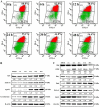Synthesis and SAR studies of novel 6,7,8-substituted 4-substituted benzyloxyquinolin-2(1H)-one derivatives for anticancer activity
- PMID: 25363404
- PMCID: PMC4337696
- DOI: 10.1111/bph.12992
Synthesis and SAR studies of novel 6,7,8-substituted 4-substituted benzyloxyquinolin-2(1H)-one derivatives for anticancer activity
Abstract
Background and purpose: 4-Phenylquinolin-2(1H)-one (4-PQ) derivatives can induce cancer cell apoptosis. Additional new 4-PQ analogs were investigated as more effective, less toxic antitumour agents.
Experimental approach: Forty-five 6,7,8-substituted 4-substituted benzyloxyquinolin-2(1H)-one derivatives were synthesized. Antiproliferative activities were evaluated using a 3-(4,5-dimethylthiazol-2-yl)-2,5-diphenyltetrazoliun bromide assay and structure-activity relationship correlations were established. Compounds 9b, 9c, 9e and 11e were also evaluated against the National Cancer Institute-60 human cancer cell line panel. Hoechst 33258 and Annexin V-FITC/PI staining assays were used to detect apoptosis, while inhibition of microtubule polymerization was assayed by fluorescence microscopy. Effects on the cell cycle were assessed by flow cytometry and on apoptosis-related proteins (active caspase-3, -8 and -9, procaspase-3, -8, -9, PARP, Bid, Bcl-xL and Bcl-2) by Western blotting.
Key results: Nine 6,7,8-substituted 4-substituted benzyloxyquinolin-2(1H)-one derivatives (7e, 8e, 9b, 9c, 9e, 10c, 10e, 11c and 11e) displayed high potency against HL-60, Hep3B, H460, and COLO 205 cancer cells (IC₅₀ < 1 μM) without affecting Detroit 551 normal human cells (IC₅₀ > 50 μM). Particularly, compound 11e exhibited nanomolar potency against COLO 205 cancer cells. Mechanistic studies indicated that compound 11e disrupted microtubule assembly and induced G2/M arrest, polyploidy and apoptosis via the intrinsic and extrinsic signalling pathways. Activation of JNK could play a role in TRAIL-induced COLO 205 apoptosis.
Conclusion and implications: New quinolone derivatives were identified as potential pro-apoptotic agents. Compound 11e could be a promising lead compound for future antitumour agent development.
© 2014 The British Pharmacological Society.
Figures















Similar articles
-
Quinolone Derivatives as Anticancer Agents: Importance in Medicinal Chemistry.Curr Top Med Chem. 2024;24(13):1134-1157. doi: 10.2174/0115680266300736240403075307. Curr Top Med Chem. 2024. PMID: 38591202 Review.
-
Discovery of novel 4(1H)-quinolone derivatives as potential antiproliferative and apoptosis inducing agents.Bioorg Med Chem Lett. 2017 Sep 1;27(17):4185-4189. doi: 10.1016/j.bmcl.2017.07.005. Epub 2017 Jul 5. Bioorg Med Chem Lett. 2017. PMID: 28757067
-
Design and synthesis of 6,7-methylenedioxy-4-substituted phenylquinolin-2(1H)-one derivatives as novel anticancer agents that induce apoptosis with cell cycle arrest at G2/M phase.Bioorg Med Chem. 2013 Sep 1;21(17):5064-75. doi: 10.1016/j.bmc.2013.06.046. Epub 2013 Jun 26. Bioorg Med Chem. 2013. PMID: 23867385 Free PMC article.
-
Design, synthesis, in vitro antiproliferative activity and apoptosis-inducing studies of 1-(3',4',5'-trimethoxyphenyl)-3-(2'-alkoxycarbonylindolyl)-2-propen-1-one derivatives obtained by a molecular hybridisation approach.J Enzyme Inhib Med Chem. 2018 Dec;33(1):1225-1238. doi: 10.1080/14756366.2018.1493473. J Enzyme Inhib Med Chem. 2018. PMID: 30141353 Free PMC article.
-
2-Anilinopyrimidine derivatives: Design, synthesis, in vitro anti-proliferative activity, EGFR and ARO inhibitory activity, cell cycle analysis and molecular docking study.Bioorg Chem. 2020 Jun;99:103798. doi: 10.1016/j.bioorg.2020.103798. Epub 2020 Mar 29. Bioorg Chem. 2020. PMID: 32247112 Review.
Cited by
-
The power of heteronemin in cancers.J Biomed Sci. 2022 Jun 15;29(1):41. doi: 10.1186/s12929-022-00816-z. J Biomed Sci. 2022. PMID: 35705962 Free PMC article. Review.
-
In Vitro and In Silico Biological Studies of 4-Phenyl-2-quinolone (4-PQ) Derivatives as Anticancer Agents.Molecules. 2023 Jan 5;28(2):555. doi: 10.3390/molecules28020555. Molecules. 2023. PMID: 36677621 Free PMC article.
-
Synthesis, Characterization and In Vitro Evaluation of Novel 5-Ene-thiazolo[3,2-b][1,2,4]triazole-6(5H)-ones as Possible Anticancer Agents.Molecules. 2021 Feb 22;26(4):1162. doi: 10.3390/molecules26041162. Molecules. 2021. PMID: 33671733 Free PMC article.
-
Quinolone Derivatives as Anticancer Agents: Importance in Medicinal Chemistry.Curr Top Med Chem. 2024;24(13):1134-1157. doi: 10.2174/0115680266300736240403075307. Curr Top Med Chem. 2024. PMID: 38591202 Review.
-
Therapeutic Potental of Quinolin-2H-one Hybrids as Anticancer Agents.Mini Rev Med Chem. 2025;25(5):386-402. doi: 10.2174/0113895575305597240912192037. Mini Rev Med Chem. 2025. PMID: 39323349 Review.
References
-
- Abonia R, Insuasty D, Castillo J, Insuasty B, Quiroga J, Nogueras M, et al. Synthesis of novel quinoline-2-one based chalcones of potential anti-tumor activity. Eur J Med Chem. 2012;57:29–40. - PubMed
-
- Ahmed N, Brahmbhatt KG, Sabde S, Mitra D, Singh IP, Bhutani KK. Synthesis and anti-HIV activity of alkylated quinoline 2,4-diols. Bioorg Med Chem. 2010;18:2872–2879. - PubMed
-
- Ahmed N, Brahmbhatt KG, Singh IP, Bhutani KK. Efficient chemoselective alkylation of quinoline 2,4-diol derivatives in water. J Heterocycl Chem. 2011;48:237–240.
-
- Ahvale AB, Prokopcová H, Šefčovičová J, Steinschifter W, Täubl AE, Uray G, et al. 4-Cyano-6,7-dimethoxycarbostyrils with solvent- and pH-independent high fluorescence quantum yields and emission maxima. Eur J Org Chem. 2008;2008:563–571.
Publication types
MeSH terms
Substances
Grants and funding
LinkOut - more resources
Full Text Sources
Other Literature Sources
Research Materials
Miscellaneous

